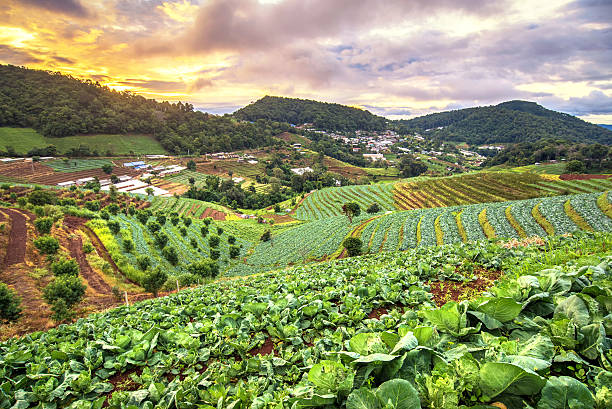Basic Steps of Organic Farming
Organic farming is an alternative method of farming that is both sustainable and environmentally friendly. The benefits of organic farming include the maintenance of soil fertility, increased yields, and a better way to care for livestock. It also avoids pollution, and it preserves biodiversity in both livestock and farmland ecosystems. It also provides adequate returns to farmers. It involves the use of safe drinking water, managing livestock, incorporating natural predators, crop rotation, and diversity.
Sustainable use of resources
Sustainable use of resources is an important aspect of organic farming. Its focus is on improving yields while not harming the environment and ecosystems. It can increase soil quality and biodiversity and help protect against environmental degradation. It also can help increase the amount of soil nitrogen and prevent soil erosion. It also enhances the environmental performance of crops by using organic agroforestry.
A number of organizations, such as the Agricultural Research Service (ARS), have published guidelines on sustainable agriculture. In the United States, the Agricultural Research Service has published the Special Reference Briefs Series 99-02 (SRB 94-5). Other sources include the National Academy of Sciences, which has published a report on agroecology and negative emissions technologies.
The efficiency of energy use by organic agriculture will depend on the management practices and the geographical location. Generally, organic agriculture uses little or no external inputs. Moreover, it involves using renewable energy sources to meet energy demands. As a result, greenhouse gas emissions are lower. Taxidis et al. investigated the energy efficiency of various organic cultivars compared to conventional cultivars. The results indicated that organic cultivars are more energy-efficient than conventional cultivars.
Organic agriculture also promotes ecosystem health and biodiversity. It limits the use of synthetic fertilizers and pesticides. It also protects farmworkers from exposure to harmful chemicals. By eliminating artificial inputs, farmers improve the working conditions of their workers and improve their health. A key goal of organic agriculture is to eliminate all forms of chemical pesticides and fertilizers.
Organic agriculture takes a longer-term view, which requires a more holistic accounting of resources. This type of farming is more productive and resilient, and invests in future ecosystem health. In the long run, organic agriculture can reduce the impact of climate change. It also fosters a more proactive approach to problems and enables earlier solutions.
High yields
Organic farming has many benefits, but it also has disadvantages. For example, it may decrease yield stability, increase disease pressure, and have less opportunities to control pests. In addition, organic fertilisers are often delayed in their release, and this affects plant yield. Most conventional fertilisers are available in the field almost immediately. Furthermore, past and current breeding programs have tended to focus on high-yielding varieties, with very little selection for organic traits.
High yields from organic farming depend on a number of factors, including proper feeding, irrigation, and pest monitoring. A typical organic orchard has a density of apple trees, just as conventional farming does. This method of organic farming requires less water and fertilizer, which helps it produce higher yields. However, organic farming can also be more costly than conventional farming, and there are other costs associated with organic production.
The benefits of organic farming go beyond food production. These benefits include preserving natural ecosystems and improving soil quality. Organic farming also helps to protect the environment by reducing the emissions of greenhouse gases. Organic farming also benefits human nutrition and health. Moreover, organic farming can improve the profitability of farms. However, a focus on higher yields can lead to a conflict between the higher yields and higher prices for consumers.
Organic farming has been linked to better energy efficiency. Compared to conventional farming, organic farms use 21% less energy. However, this number varies widely by product and study.
Alternatives to conventional farming
The world’s population is rising, and food is becoming scarce in some regions. To solve this problem, scientists are exploring alternative farming methods. One of the most promising examples is vertical farming. This new method integrates techniques from controlled-environment agriculture and indoor farming. Growing crops vertically in greenhouses is a great alternative to conventional farming.
This approach focuses on the ecosystem rather than production and yield. This has the advantage of preserving the soil ecology, while also reducing the cost of farming inputs. Another advantage is the high yields and profits of alternative farming systems. Agroecology helps farmers increase soil fertility, adapt to climate change, and decrease farming input costs. In contrast, conventional farming methods rely on monocropping, chemical fertilisers, and other resources that are inefficient and costly. In addition, conventional farming requires massive amounts of fossil fuels and resources for energy and land.
Sustainable agriculture is a popular alternative to conventional farming, and it is increasingly becoming the norm. The use of synthetic pesticides, fertilizers, and water can negatively impact the environment. Sustainable farming practices rely on minimizing these negative effects and maintaining the health of the soil and water. In addition, organic farming practices are free of harmful chemicals, which help minimize the impact on the environment.
In addition, farmers can learn about sustainable farming methods from other farmers. The Rodale Institute’s networking program allows farmers to share information about their experiences and answer each other’s questions. It also has cooperative programs with universities around the world. These include Michigan State University, the Northeast Forestry University, and the Jiangsu Academy of Agricultural Sciences.
Costs
There is a wide range of costs associated with organic farming. However, one of the most significant is the cost of cropland, which organic farmers pay more than conventional farms. According to a USDA survey from 2003 to 2011, organic farms paid 23% more rent than conventional farms for their cropland. In addition, their cropland values were 26% higher.
The cost of farmland is one of the biggest barriers to entry for new farmers. Since beginning farms are typically much smaller than established farms, many young farmers with limited capital are more likely to make the switch to organic farming. However, due to the high cost of inputs, they may need to borrow money to buy seeds and other materials, which will increase their debt. As a result, switching to organic farming may decrease overall yield and/or require reducing the size of the operation.
Organic farming is also more expensive than conventional farming because it requires more labor. Organic farmers must perform more manual tasks such as weeding and mechanical pest control. In addition, organic farmers must spend more on marketing their products. However, they can also save on costs by joining a community supported agriculture (CSA) program.
Another important factor in evaluating the costs of organic farming is the price premium. Some studies compare output prices at the same price levels for organic and conventional farms. Researchers also use data from similar cropping systems to calculate the profit of an organic farm. They look for the difference between the two and try to apply the organic price premium to that.
Although the price premium for organic crops is higher than conventional crops, it may not last forever. For example, Washington State University researchers found that organic crops yield 18 percent less than conventionally grown crops. Nonetheless, the price premium can be higher than the breakeven point for conventional farming.
Business model
A business model for organic farming should include a clear description of farm operations, payment structures, and long-term goals. The business plan should also incorporate financial planning to determine the viability of the business. It should include startup costs for farm equipment, land, machinery, and labor. It should also outline your marketing and pricing strategy.
The financial viability of an organic farming business depends on the producer’s ability to control sufficient assets. For example, a small farm may not have the space needed for field crops or equipment for marketing and selling. A livestock operator will also need adequate land and a nutrient management plan for organic production. A stable financial structure will help protect farm assets, especially in the transitional period.
The cost of organic products is higher than conventional products. However, a business model for organic products can overcome this problem by targeting a niche audience. As organic products are not treated with chemicals, they have a shorter shelf life. Nevertheless, there are a few success stories in the organic farming industry in India.
Organic farming is becoming increasingly popular as people become aware of the health benefits of eating organic foods. The market for organic products is growing rapidly and can be profitable for a farmer. Organic farming is also environmentally friendly, as it does not use harmful pesticides or fertilizers. Furthermore, it protects the environment by preventing groundwater pollution. The main advantage of organic farming is that there is no need for fertilizers and chemicals. Unlike conventional farming, it is also cheaper to operate.
The business model of organic farming requires an employee that can manage the production process. The minimum number of employees should be two to five. Those employees must be trained on the proper use of equipment and machinery and understand safety procedures.













